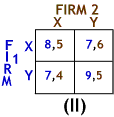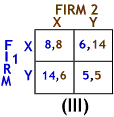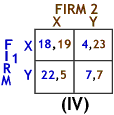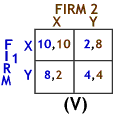| 5. Payoff Matrix | Description |
 | First notice that Game I has no dominant strategies for either player. Closer examination will reveal that there are no Nash equilibria in pure strategies either. Both players will choose mixed strategies for this game, which is a bit like the matching coins game. In particular, Firm 2 would like to always play the same strategy as Firm 1 (x when Firm 1 plays x and y when Firm 1 plays y) |
 | Firm 1 doesn't have a dominant strategy for this game, but Firm 2 does. Firm 2's dominant strategy is to always play y. Knowing this Firm 1 will always play y so we can predict the outcome of this game, both firms choosing y. |
 | Game III has no dominant strategies for either players but there are two Nash equilibria in pure strategies. Firm 1 y, Firm 2 x and Firm 1 x, Firm 2 y are both Nash equilibria. Unfortunately we have no good method for predicting one over the other. Because total industry payoffs are highest at the two Nash equilibria this is a game in which the firms might wish to take turns playing x and y, which is like the outcome in which firms take turn being the high-price firm. |
 | Game IV is an oligopolists' dilemma payoff matrix. For both firms the dominant strategy for one-time play is y. Yet if both firms play their dominant strategy payoffs are far lower than if both could agree on x. |
 | Game V has two Nash equilibria x x and y y. The payoffs for both firms playing x are much better than when both play y. This payoff matrix could have resulted from a prisoners' dilemma in which the two firms implimented low-price guarantees reducing the payoffs to charging the low price. |











